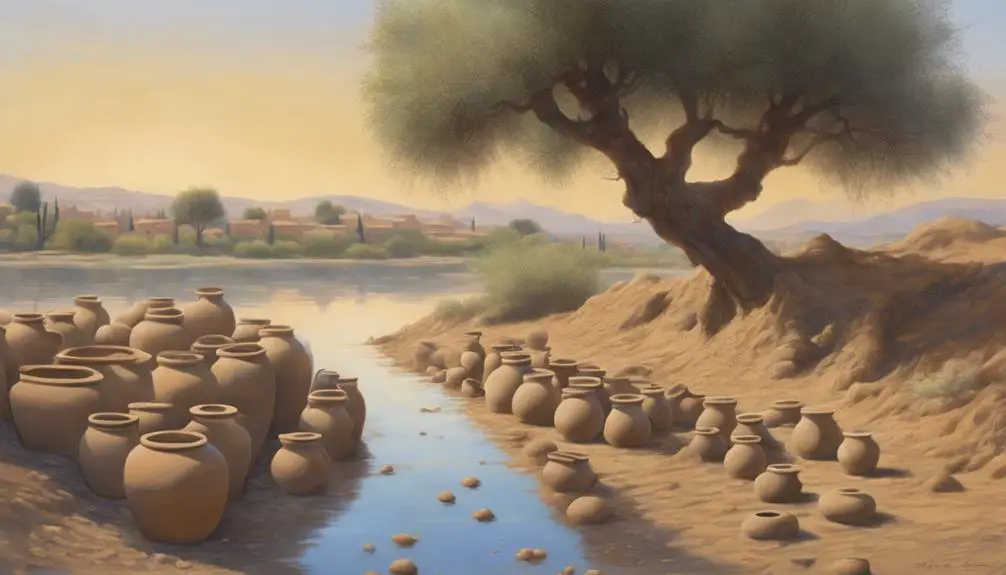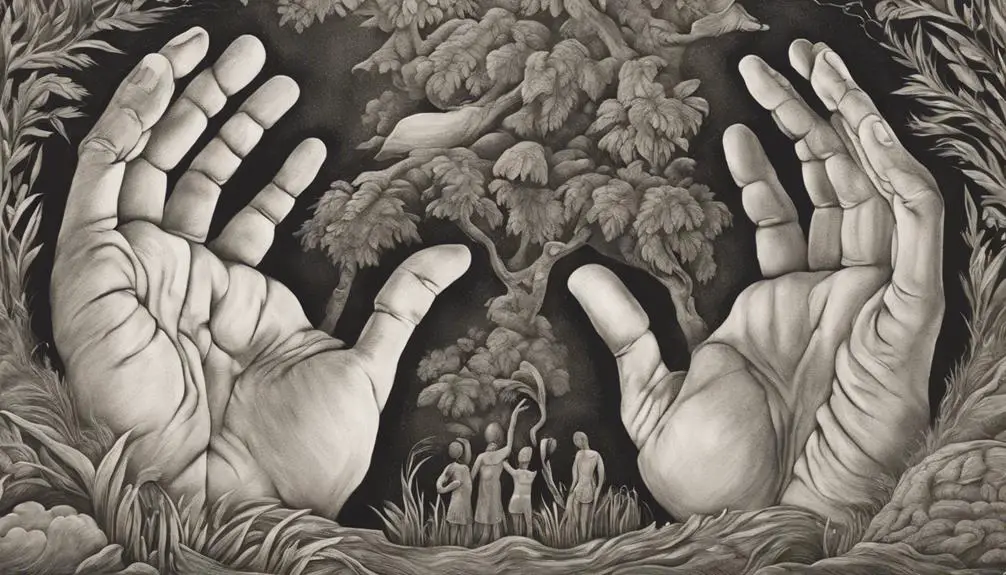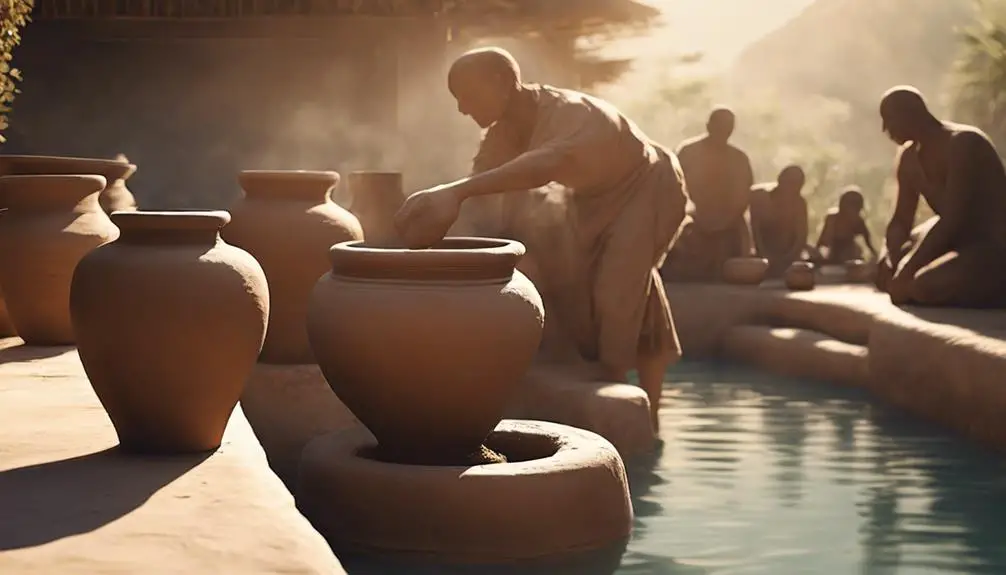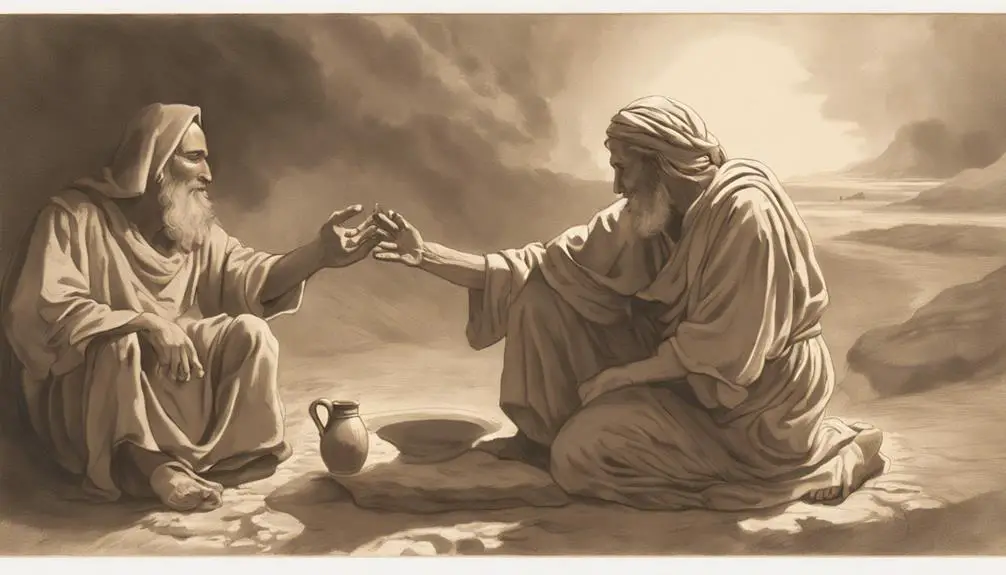Discover how mud's humble presence in the Bible unveils profound messages of creation, healing, and divine purpose, inviting deeper exploration.

Significance of Mud in the Bible
Mud in the Bible isn't just dirt under your feet; it's a cornerstone of some of the most profound narratives. You've likely heard how God sculpted Adam from the earth, but have you considered the deeper implications of mud's role in biblical stories?
From the creation of man to the healing of the blind, mud symbolizes humility, transformation, and divine intervention. As you explore these ancient texts, you'll find that mud isn't merely a substance, but a powerful metaphor for change and faith.
So, why is this seemingly mundane material so pivotal in biblical tales? Join the conversation and uncover the layers of meaning waiting beneath the surface.
Key Takeaways
- Mud symbolizes the connection between humanity and the earth, emphasizing humility and stewardship.
- It represents transformation and spiritual renewal, from darkness to enlightenment.
- Acts as a symbol of humility and submission, reminding us of our mortality and dependence on God.
- Serves as a medium for divine intervention, illustrating God's power through earthly elements.
Creation of Adam

In the biblical narrative, God forms Adam from the dust of the ground, illustrating a profound connection between humanity and the earth. This act of creation, emblematic of divine craftsmanship, imbues material significance into the very fabric of human existence. You're drawn into a world where every grain of dust underpins the sanctity and origin of life, a testament to the meticulous care and intentionality of the divine creator.
The choice of dust and mud as the medium for this creation narrative isn't arbitrary. It signals a fundamental truth about human nature and destiny. You, as a part of humanity, are reminded of your origin from and eventual return to the earth, a cycle that underscores the humility and temporality of human life. The material significance of dust, therefore, extends beyond a mere physical component; it becomes a symbol of life's fragility and a call to mindful stewardship of the earth.
Moreover, divine craftsmanship in the creation of Adam from mud highlights a dual message of humility and potential. You're invited to ponder over your humble beginnings, yet also recognize the potential imbued in you by the divine, a unique blend of the earthly and the heavenly, tasked with the stewardship of creation itself.
Healing of the Blind

Through the narrative of healing the blind, the Bible further explores the transformative power of mud, revealing its role not only in creation but also in restoration and spiritual enlightenment. This act isn't merely a miracle but a deeply symbolic gesture, rich in cultural interpretations and rooted in historical contexts.
In analyzing this event, you'll uncover:
- Cultural Interpretations: Various cultures have understood the healing of the blind through mud as a metaphor for spiritual awakening. This act transcends the physical realm, suggesting that enlightenment requires humility and faith.
- Historical Contexts: In ancient times, mud was a fundamental element in everyday life, used in construction, medicine, and rituals. Its use by Jesus to heal the blind man bridges divine intervention with common earthly materials, emphasizing God's presence in the mundane.
- Symbolic Significance: Beyond its healing properties, mud symbolizes transformation. From blindness to sight, the application of mud illustrates a journey from darkness to light, ignorance to understanding, echoing the biblical theme of redemption.
This narrative invites you to ponder the profound connections between materiality and spirituality, encouraging a deeper appreciation of the biblical text's multifaceted layers.
Symbol of Humility

Mud, as depicted in biblical narratives, serves as a profound symbol of humility, challenging you to reevaluate your understanding of divine interaction and human vulnerability. This element, often overlooked, carries significant theological weight, inviting a deeper reflection on the role of humility in spiritual growth and divine encounters. Mud rituals, as observed in various biblical passages, aren't merely acts of cleansing or healing but are imbued with layers of meaning, reflecting cultural perceptions of humility, purity, and human condition.
In analyzing these narratives, it's evident that mud—representing dirt, Earth, and by extension, our origin—isn't just a physical substance but a metaphorical tool used to convey messages of humility and submission. The cultural perceptions of the time viewed interactions with mud not as demeaning but as acts reminding individuals of their mortality and dependence on God. Through these engagements, you're invited to see beyond the surface, recognizing the humility required to accept divine will and guidance.
Hence, the biblical use of mud transcends its literal applications, offering a rich tapestry for understanding humility's place in human-divine relationships. It prompts a reevaluation of how you perceive humility, not as weakness but as a cornerstone of spiritual enlightenment and connection.
Metaphor for Transformation

Beyond its physicality, mud serves as a potent metaphor for transformation, illustrating the profound journey from spiritual barrenness to rejuvenation. This imagery isn't merely about the physical act of cleansing or shaping but delves deep into the essence of human existence, reflecting on spiritual renewal and life's impermanence. Through this lens, mud symbolizes a fundamental shift, a rebirth that speaks to the core of the Biblical narrative.
Consider these aspects:
- The Process of Becoming: Mud, in its malleable state, represents the transformative process we undergo, shaping our spiritual selves towards enlightenment and understanding.
- Renewal and Growth: Just as seeds sprout from the earth, spiritual renewal emerges from the depths of our trials and tribulations, signifying growth and the promise of new life.
- Acknowledgment of Impermanence: Mud's eventual drying and cracking echo life's impermanence, reminding us that our physical existence is transient, but our spiritual journey carries forward.
In analyzing these elements, it's clear that mud's significance extends beyond mere symbolism. It encapsulates the essence of transformation, serving as a vivid illustration of the path from desolation to spiritual awakening, emphasizing the cyclical nature of life and the continuous quest for deeper understanding and connection.
Medium of Divine Intervention

In biblical narratives, mud frequently acts as a conduit for divine intervention, illustrating how God intervenes in the material world to facilitate transformation and deliverance. This depiction of mud as a medium through which the divine operates can be understood as both literal and metaphorical. Within the sacred texts, 'mud miracles' serve as pivotal moments where human understanding of the natural world is transcended, showcasing the limitless power of God.
The concept of 'Divine mud' extends beyond its physicality, symbolizing the intersection between the divine will and earthly elements. It's a representation of how God's interventions are often rooted in the tangible, utilizing the humblest of materials to manifest His glory and enact change. These narratives challenge you to see beyond the ordinary, recognizing the potential for the divine in all aspects of the created world.
Through these accounts, the Bible underscores a profound message: God's presence and power are immanent in the world, capable of transforming the mundane into the miraculous. The use of mud—a substance associated with impurity and lowliness—highlights the principle that no element is too insignificant to serve as a vessel for divine purposes.
Frequently Asked Questions
How Has the Interpretation of Mud's Symbolism in the Bible Changed Over Different Historical Periods and Within Various Christian Denominations?
You've noticed how interpretations of mud symbolism have evolved, reflecting historical shifts and varying across Christian denominations.
In earlier periods, mud's significance was often literal, linked to creation and healing stories. Over time, scholars and theologians began to see deeper metaphors for sin, purification, and transformation.
This shift mirrors broader theological debates and cultural changes, demonstrating how religious symbols adapt to new understandings and contexts within the faith's diverse branches.
Are There Any Rituals or Traditions in Modern Christianity That Still Use Mud as a Symbolic or Literal Element, Outside of the Contexts Mentioned?
You're asking if modern Christianity incorporates mud in rituals or traditions beyond previously mentioned contexts.
While not widespread, some groups use mud facials during spiritual retreats, symbolizing purification and renewal.
Additionally, mud as a construction material mirrors the biblical symbolism of creation and foundation in building projects, particularly in communities focusing on ecological sustainability.
These practices, though not mainstream, reflect a continued, symbolic appreciation of mud's earthy essence within certain Christian circles.
How Do Other Religious Texts Outside of Christianity View and Interpret the Significance of Mud, Especially in the Creation of Humanity or in Miraculous Events?
Musing on mud, you'll find it's a fundamental feature in various religious texts beyond Christianity, especially regarding the creation of humanity and miraculous events.
In Islamic Creation narratives, mud plays a pivotal part, portraying the physicality of humans.
Hindu rituals, too, hold mud in high esteem, symbolizing both purity and the cyclical nature of life.
These perspectives offer a rich, analytical view, underscoring mud's universal symbolism across diverse traditions.
Can the Use of Mud in the Bible Be Linked to Any Environmental or Ecological Teachings, Emphasizing the Relationship Between Humans and the Earth?
You're exploring if mud rituals in the Bible carry ecological or environmental messages about Earth stewardship. This quest seeks to understand whether these ancient narratives underscore a symbiotic relationship between humans and the earth.
Has the Concept of Mud in the Bible Influenced Any Major Works of Art, Literature, or Music Throughout History, Beyond Direct Biblical Adaptations?
You're exploring how mud has left its mark on art, literature, and music, extending far beyond biblical stories.
This element's influence is profound, from inspiring mud sculptures that capture the raw essence of creation to being the thematic heart of mud festivals celebrating earth's gifts.
These cultural expressions delve deep into humanity's bond with nature, showcasing how this simple mixture of earth and water has shaped significant artistic and cultural narratives throughout history.
Conclusion
In conclusion, mud holds profound significance in the biblical narrative. It serves as a foundation for creation, a means for miraculous healing, and a symbol for both humility and transformation. It's a vivid reminder that from humble beginnings, great things can emerge.
As the adage goes, 'From dust you have come, and to dust you'll return,' underscoring the cyclical nature of life and divine intervention. Analyzing mud's role in the Bible offers a deeper understanding of its theological and metaphysical implications.



Sign up